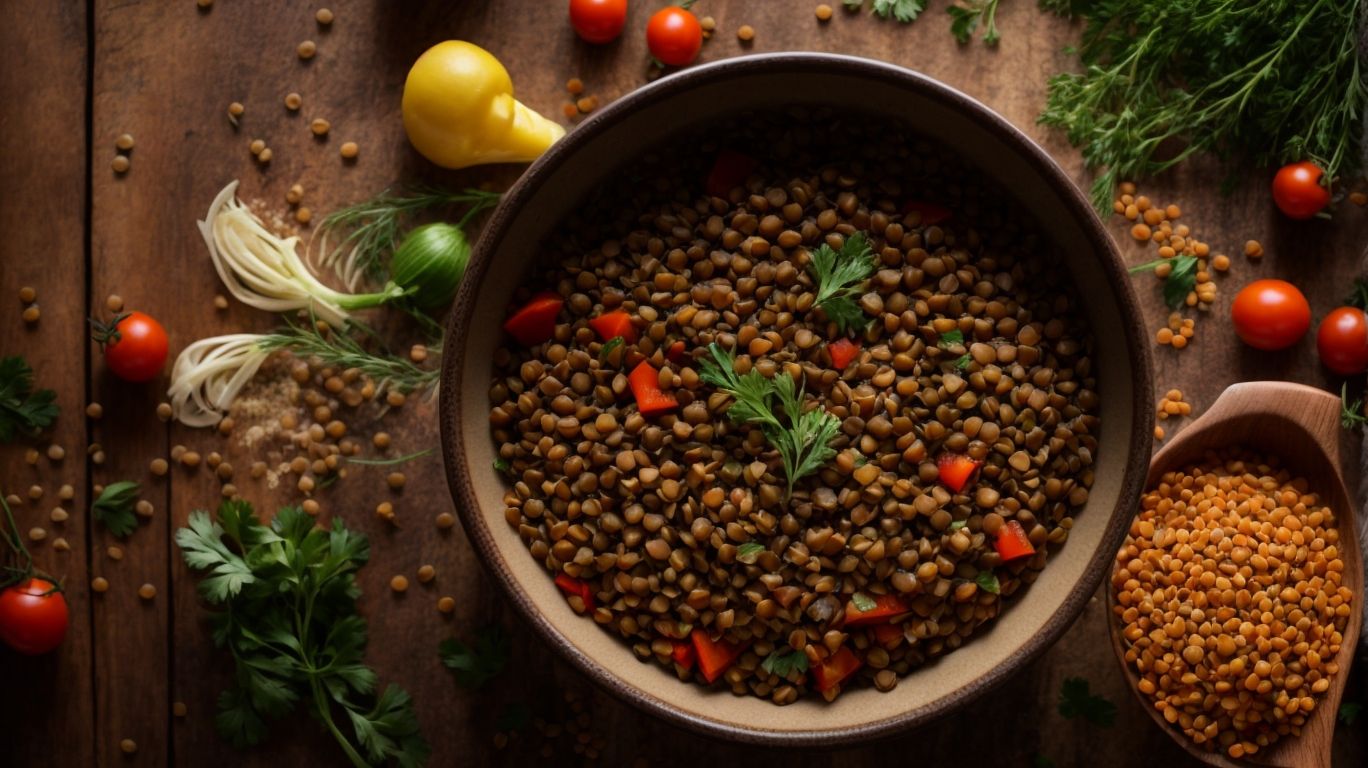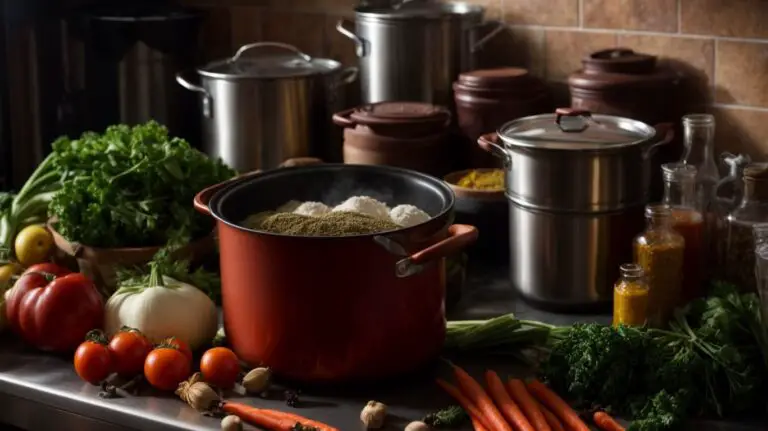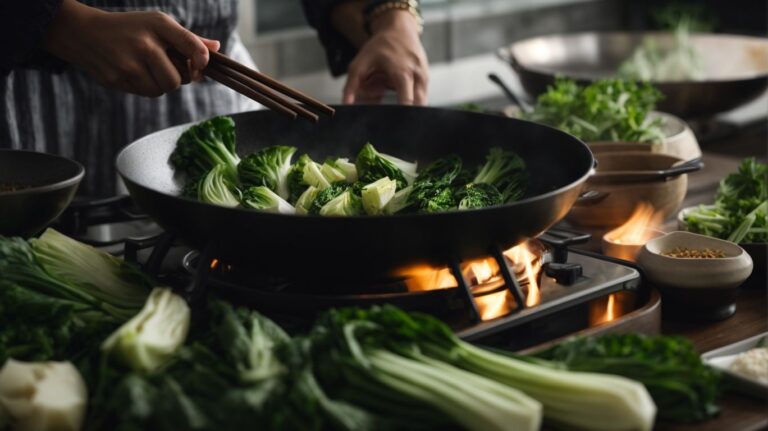How to Cook Lentils for Soup?
Looking to elevate your soup game with the addition of lentils?
Culinary expert Chris Poormet shares his expertise on how to cook lentils for soup.
From the different types of lentils to choosing the right one for your recipe, sorting and rinsing techniques, cooking methods, and a delicious lentil soup recipe, Chris covers it all.
Avoid common mistakes and learn valuable tips for making the perfect lentil soup.
Dive into this article to enhance your culinary skills and create a flavorful and comforting bowl of soup.
Key Takeaways:
About the Author – Chris Poormet
Chris Poormet, the renowned owner of Poormet.com, has been recognized as the Culinary Blogger of the Year and boasts a prestigious background as a former chef with expertise in food photography.
Chris’s culinary journey began in the bustling kitchens of renowned restaurants, where he mastered the art of creating exquisite dishes that tantalize the taste buds of patrons. His transition from a professional chef to a prominent food blogger has been nothing short of inspirational. With a keen eye for detail and a passion for showcasing the beauty of food through food photography, Chris has garnered a devoted following of food enthusiasts eager to replicate his culinary creations. His blog, Poormet.com, serves as a hub of culinary inspiration, offering innovative recipes, culinary tips, and engaging content that resonates with his audience.
What Are Lentils?

Credits: Poormet.Com – Logan Lopez
Lentils, a versatile legume widely used in culinary creations, come in various types such as red, green, brown, and French lentils, each offering distinctive flavors and textures.
Red lentils, also known as Egyptian lentils, are popular for their quick cooking time and ability to break down easily, making them ideal for soups, stews, and dals.
Green lentils, on the other hand, maintain their shape well when cooked, adding a firm texture to salads and side dishes.
Brown lentils are commonly used in hearty meals like casseroles and curries due to their earthy flavor and ability to hold up during longer cooking times.
French lentils, also called Puy lentils, are renowned for their peppery taste and ability to retain their shape, making them perfect for salads and as a standalone side dish.
Why Use Lentils in Soup?
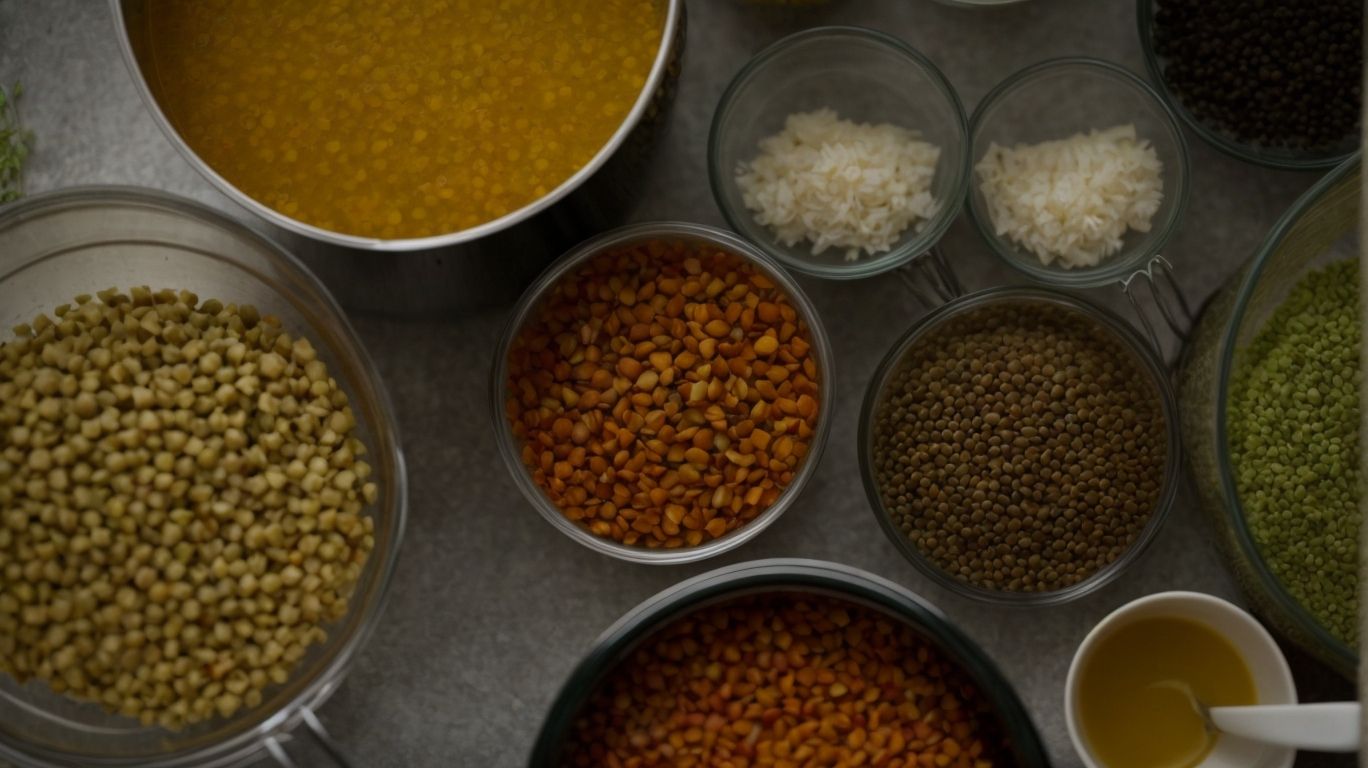
Credits: Poormet.Com – Robert Clark
Incorporating lentils into soups not only enhances their flavor profiles with a satisfying array of spices but also boosts their nutritional value by adding essential proteins and promoting heart health.
Lentils are a versatile ingredient that can absorb the fragrant flavors of various herbs and seasonings, making them a perfect base for creating hearty and comforting soups. When simmered with vegetables and a blend of aromatic spices, lentils release their creamy texture and earthy taste, elevating the overall taste experience of the soup.
Lentils are a powerhouse of plant-based protein, making them an excellent choice for those looking to increase their protein intake without relying on meat. This makes lentil soups not only a delicious meal but also a nutritious option for maintaining a balanced diet.
How to Choose the Right Lentils for Soup?
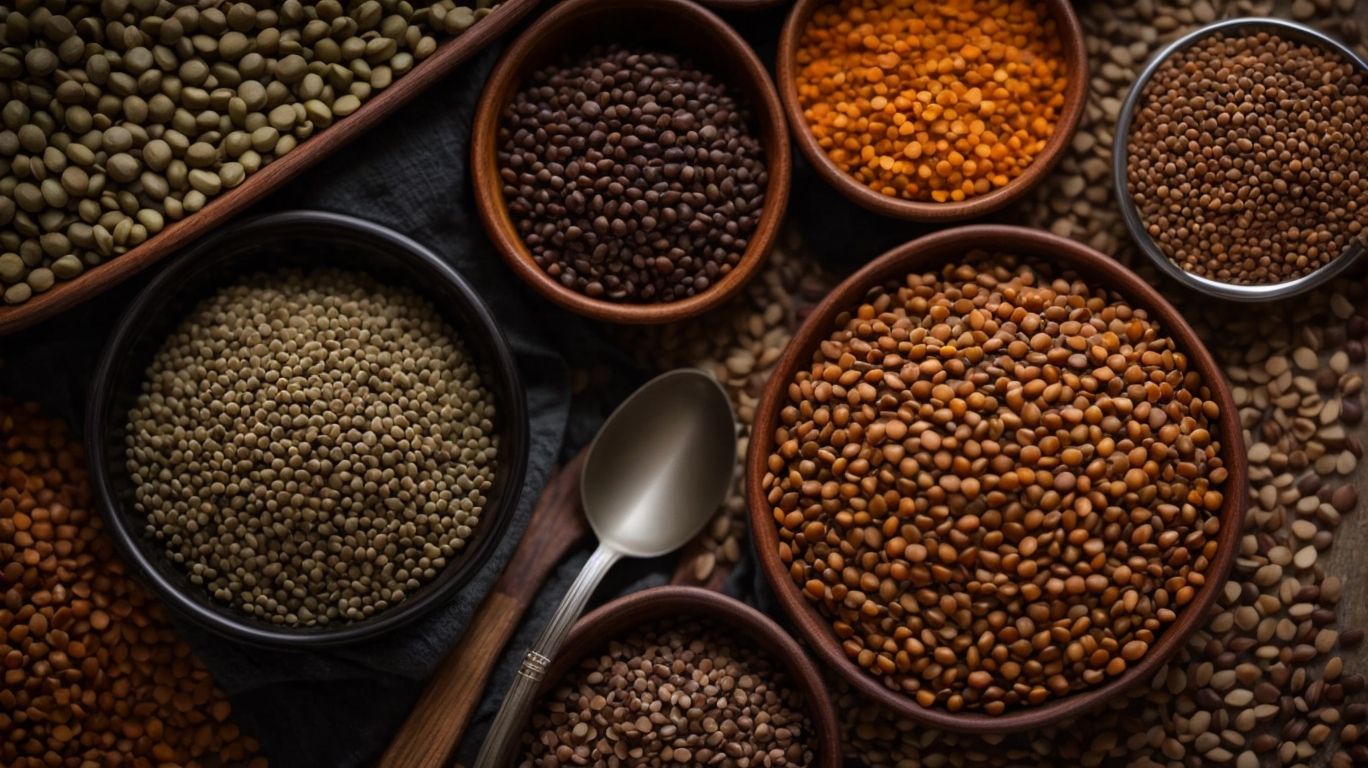
Credits: Poormet.Com – Jonathan Perez
Selecting the appropriate type of lentils for your soup recipe is crucial; whether opting for red lentils for a quicker cook time or green lentils for a firmer texture, the choice impacts the dish’s final outcome.
In terms of brown lentils, they hold their shape well, making them ideal for hearty soups or stews where you want a slightly firm texture.
On the other hand, French lentils, also known as Puy lentils, are smaller in size and have a peppery flavor, adding a unique taste profile to your soup dishes.
Each type of lentil brings its own characteristics to the table, so consider the desired consistency and flavor profile when selecting the perfect one for your next soup creation.
Red Lentils
Red lentils, known for their rapid cooking time and soft consistency, are ideal for creating creamy soups that burst with delightful flavors and textures.
When cooked, these lentils break down easily, releasing a thickening effect that lends a luxurious creaminess to soups and stews. The texture of red lentils in soups is velvety-smooth, making each spoonful a comforting experience. Not only do they cook quickly, but they also absorb flavors beautifully, enhancing the taste of the entire dish. Their earthy sweetness adds depth and richness to any recipe they are a part of, elevating the overall dining experience.
Green Lentils
Green lentils, with their robust texture and ability to hold shape during simmering, infuse soups with earthy, savory notes that complement a variety of spices and seasonings.
These small, lens-shaped legumes are perfect for hearty dishes as they provide a satisfying bite and a rich, nutty flavor. Green lentils are known for their versatility, effortlessly absorbing the flavors of the spices they are cooked with.
Whether you’re preparing a traditional Indian dal or a Moroccan lentil stew, green lentils elevate the dish with their firm texture that doesn’t turn mushy when cooked. They add a wholesome element to salads and pilafs, bringing a protein-packed option to vegetarian meals.
Brown Lentils
Brown lentils, renowned for their nutty flavor and ability to absorb seasonings beautifully, are popular choices for hearty soups enriched with diverse ingredients and robust seasonings.
What makes brown lentils stand out is their earthy taste profile, which adds a depth of flavor to dishes. Due to their firm texture, they hold up well in soups, stews, and salads without turning mushy, making them a versatile ingredient for various culinary creations. Their natural ability to soak up flavors allows them to harmonize with herbs, spices, and broths, enhancing the overall taste experience. Whether simmered in a savory broth or paired with aromatic spices, these legumes bring a satisfying and wholesome element to meals.
French Lentils
French lentils, known for their distinct peppery flavor and firm texture, add a touch of sophistication to lentil soups, especially when paired with Mediterranean-inspired herbs and flavourings.
What sets French lentils apart is their ability to retain their shape and texture even after cooking, making them ideal for salads and side dishes. The earthy undertones of these lentils complement the robust flavors of Mediterranean ingredients such as garlic, olive oil, and fresh herbs like thyme and rosemary. They also cook more quickly than other varieties of lentils due to their thin skin, saving time in meal preparation.
When simmered in a broth with tomatoes, onions, and a hint of balsamic vinegar, French lentils develop a rich depth of flavor that elevates any dish they are added to. Their versatility extends beyond soups and stews; they can be used in cold salads or warm grain bowls to add protein and a satisfying bite. With their distinctive taste and texture, French lentils are a gourmet ingredient that brings a touch of elegance to everyday meals.
How to Prepare Lentils for Soup?
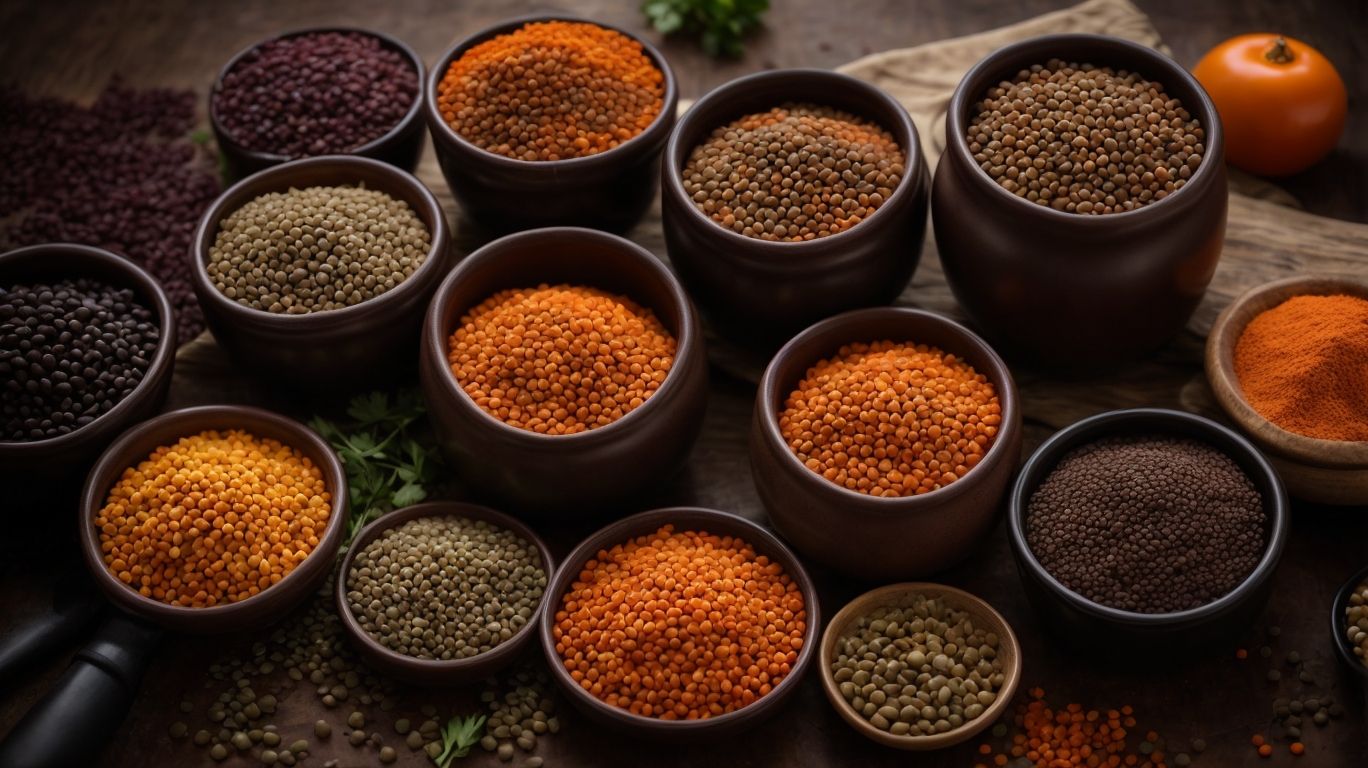
Credits: Poormet.Com – Bobby Taylor
Preparing lentils for soup involves essential steps such as sorting, rinsing to remove impurities, soaking to aid in cooking consistency, and choosing appropriate cooking methods to achieve the desired texture and flavor.
Sorting the lentils is the initial step that ensures removal of debris, stones, or any damaged beans.
Once sorted, giving them a good rinse under running water not only cleans them but also washes away any residual dust or dirt.
Soaking the lentils before cooking is crucial as it helps in reducing the cooking time and improves their digestibility.
There are different methods of soaking – overnight soaking or quick soaking by pouring boiling water over the lentils.
Moving on to cooking methods, lentils can be boiled, simmered, pressure-cooked, or even cooked in a slow cooker, each resulting in a unique texture and taste for your soup.
Sorting and Rinsing
The initial steps of sorting and rinsing lentils are crucial for ensuring their cleanliness, removing impurities, and enhancing the overall quality of the lentil soup.
Sorting the lentils meticulously before cooking helps in removing any debris, small stones, or damaged lentils that might have made their way into the batch. This process not only improves the visual appeal of the lentils but also plays a significant role in maintaining hygiene standards.
Rinsing the lentils under cold water is essential to wash away any remaining dust, dirt, or natural coatings that can impart a gritty texture to the soup. By eliminating these impurities, you are not only enhancing the flavor but also ensuring a smoother consistency in the final dish.
The act of sorting and rinsing lentils is a simple yet effective technique that can elevate the overall experience of enjoying a hearty bowl of lentil soup. The attention to detail in these initial stages sets the foundation for a delicious and wholesome meal that is free from unwanted contaminants.
Soaking
Soaking lentils before cooking aids in achieving consistent texture and cooking results, ensuring that the lentil soup maintains the desired quality and mouthfeel.
When lentils are soaked, they absorb moisture gradually, allowing them to cook more evenly and efficiently.
This process also helps to shorten the overall cooking time, making it easier to prepare a flavorful and well-balanced lentil soup.
Moreover, soaking can enhance the digestibility of lentils, making them easier on the stomach and boosting their nutritional value.
Cooking Methods
Various cooking methods, such as simmering with aromatic spices and a hint of lemon zest, can elevate the flavors and textures of lentil soups, creating a delightful culinary experience.
Simmering lentil soups with a medley of spices allows for the deep infusion of flavors while retaining the lentils’ natural goodness and nutritional value. Lemon zest adds a refreshing citrusy note, balancing the richness of the lentils and spices. Playing with the intensity of simmering can alter the soup’s consistency, from hearty and thick to light and brothy, catering to diverse preferences. The selection of spices, from cumin and coriander to paprika and turmeric, imparts distinct layers of taste that harmonize beautifully with the lentils.
Recipe for Lentil Soup
Indulge in a delectable recipe for lentil soup that promises a harmonious blend of premium ingredients, easy-to-follow instructions, and a luxuriously creamy texture that will captivate your taste buds.
Beginning with the warming aroma of sautéed onions and garlic, this lentil soup recipe brings together the earthy flavors of lentils, the sweetness of carrots, and the tang of tomatoes for a truly satisfying dish. As the ingredients meld together in a flavorful symphony, adding a sprinkle of herbs like thyme or rosemary enhances the complexity of each spoonful. To achieve that irresistibly creamy texture, a dollop of coconut milk or a swirl of yogurt is stirred in at the end, creating a velvety consistency that elevates this soup to a whole new level.
Ingredients
Gather the finest ingredients for your lentil soup, including a medley of lentils, aromatic spices, and flavour-enhancing additions that will transform your culinary creation into a masterpiece.
If you’re aiming for a robust lentil soup, start with selecting the right type of lentils. Common choices like green, brown, or red lentils each bring a unique texture and flavor to the dish. Lentils are not only rich in protein and fiber but also cook relatively quickly, making them perfect for a hearty soup.
As for spices, classics like cumin, coriander, and smoked paprika can elevate the earthy notes of lentils. Adding a dash of turmeric not only imparts a vibrant hue but also offers a subtle warmth to the soup.
Don’t forget the flavorings that will round out the taste profile. Ingredients such as caramelized onions, garlic, and a splash of balsamic vinegar can enhance the depth and complexity of your lentil soup.
Instructions
Follow these easy instructions to create a sumptuous lentil soup, mastering the technique of simmering with an array of spices that harmonize to perfection in each flavorful spoonful.
To begin, start by thoroughly rinsing 1 cup of dried lentils under cold water and letting them soak for about 30 minutes. While the lentils soak, chop 1 onion, 2 carrots, and 2 celery stalks finely for a flavorful base. In a large pot over medium heat, sauté the vegetables in olive oil until they soften and start to caramelize.
Next, add a tablespoon of minced garlic and your desired spices like cumin, turmeric, and a pinch of cayenne for a depth of flavor. Allow the spices to toast for a minute before pouring in 6 cups of vegetable broth and the soaked lentils.
Reduce the heat to low, cover the pot, and let the lentil soup simmer for about 25-30 minutes, stirring occasionally to prevent sticking. Taste and adjust the seasoning with salt and pepper as needed.
Tips for Cooking Lentil Soup
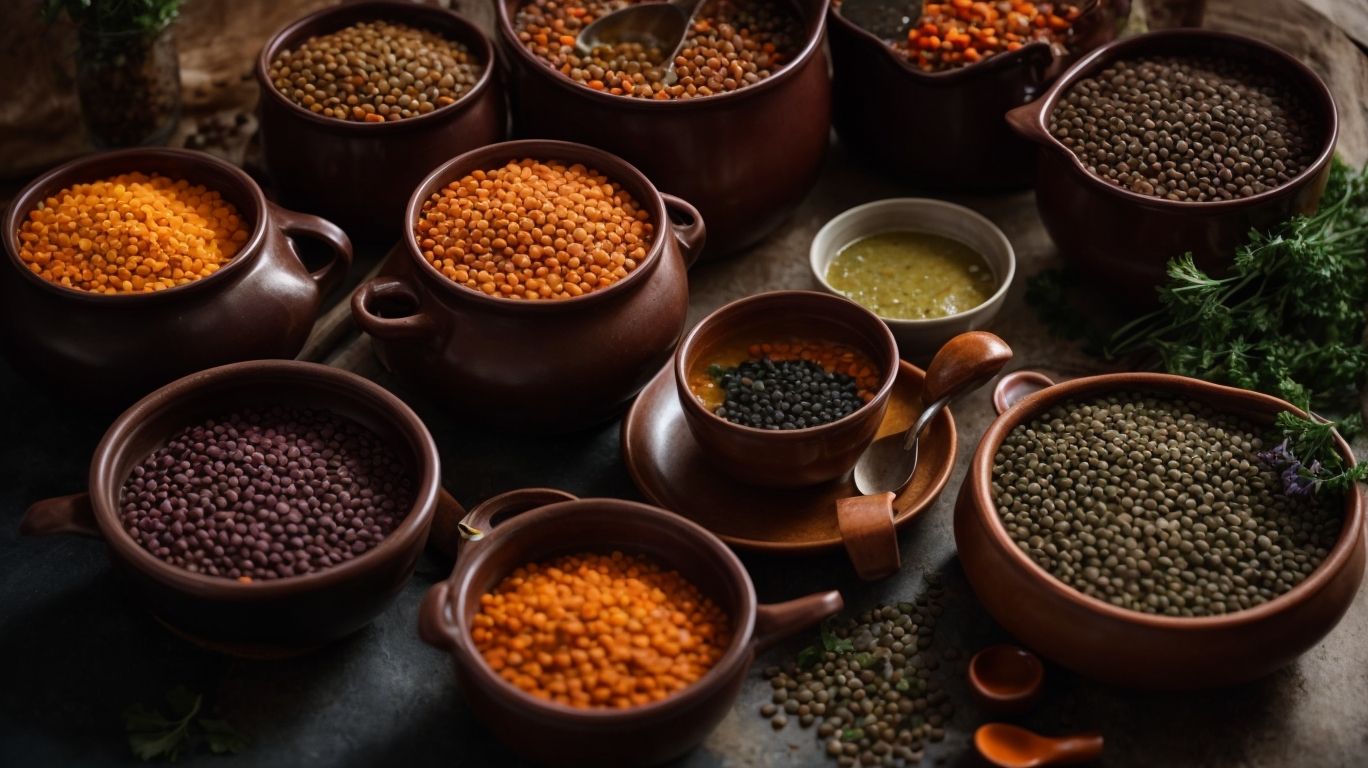
Credits: Poormet.Com – Mason Brown
Enhance your lentil soup preparation with expert tips on infusing rich flavors, adjusting thickness to your preference, and presenting creative serving suggestions that elevate the dining experience.
When aiming to elevate the flavors of your lentil soup, consider incorporating aromatic spices such as cumin, coriander, or smoked paprika for a depth of taste that will impress your taste buds. Experimenting with different herbs like fresh parsley, cilantro, or a squeeze of lemon juice can add a refreshing twist to your bowl. You can enhance the umami profile by sautéing onions, garlic, and carrots before adding the lentils and broth.
To adjust the thickness of your lentil soup, you can control the amount of broth or water used during cooking. If you prefer a thicker consistency, allow the soup to simmer uncovered to reduce some of the liquid, or utilize an immersion blender for a smoother texture. Adding a splash of coconut milk or heavy cream can also enrich the soup’s creaminess without compromising the flavors.
For innovative serving ideas that will impress your guests, consider topping each bowl of lentil soup with a dollop of Greek yogurt, a sprinkle of toasted nuts or seeds for crunch, or a drizzle of high-quality olive oil for a luxurious finish. Pairing the soup with crusty bread, a side salad, or savory muffins can turn a simple meal into a memorable dining experience.
Adding Flavor
Elevate the flavor profile of your lentil soup by incorporating a blend of aromatic spices, carefully selected seasonings, and the rich essence of caramelized vegetables that impart depth and complexity.
One of the best ways to enhance the taste of your lentil soup is through the artful use of spices. The warmth of cumin, the earthiness of coriander, and the subtle heat of paprika can all work harmoniously to create a symphony of flavors in your soup.
To further elevate the dish, consider incorporating a mix of seasonings such as bay leaves, thyme, or a touch of garam masala for an added dimension of taste.
In terms of caramelized vegetables, the sweetness they bring can balance out the earthy tones of the lentils. Onions, carrots, and even a hint of roasted garlic can transform your soup into a culinary masterpiece.
Making it Thicker or Thinner
Achieve the desired consistency of your lentil soup by mastering the art of balancing its thickness, ensuring a luscious and creamy texture that tantalizes the palate with each spoonful.
One key tip to achieve a creamy consistency in your lentil soup is to adjust the amount of liquid used in the recipe. Too much liquid can result in a thin and watery soup, while too little can make it overly thick.
To thin out an overly thick soup, simply add more broth or water gradually until you reach your desired texture. On the other hand, if your soup is too thin, you can thicken it by simmering it longer without the lid on, allowing some of the liquid to evaporate and naturally thicken the soup.
Experimenting with different cooking times and temperatures can also impact the thickness of your lentil soup. Cooking at a lower heat for a longer period can help the lentils break down and release starches, creating a thicker soup. Conversely, cooking at a higher heat can reduce the liquid faster and result in a denser consistency.
Remember, achieving the perfect creamy texture in your lentil soup may require some trial and error, but with these tips, you will be well on your way to mastering the consistency that suits your preferences.
So, take control of the thickness of your lentil soup and transform it into a velvety delight that will warm your soul and delight your taste buds.
Serving Suggestions
Enhance the presentation of your lentil soup with creative serving suggestions, such as pairing it with warm homemade bread, incorporating Mediterranean-inspired elements, and catering to vegetarian preferences with innovative twists.
One way to elevate the flavors of your lentil soup is to serve it in bread bowls made from your freshly baked homemade bread. This not only adds a delightful texture contrast but also makes for an impressive presentation. For a Mediterranean-style touch, consider garnishing your soup with a drizzle of flavorful olive oil, a sprinkle of crumbled feta cheese, and a dash of fresh herbs like oregano or parsley.
If you’re looking to offer vegetarian variations, experiment with adding roasted vegetables, such as grilled eggplant or roasted red peppers, to your lentil soup. You can also create a colorful and nutritious topping by preparing a refreshing avocado salsa or a zesty tomato and cucumber salad to accompany the soup.
Common Mistakes When Cooking Lentil Soup
Avoid common pitfalls when preparing lentil soup, such as overcooking that leads to mushy textures, inadequate seasoning resulting in bland flavors, and using the wrong type of lentils that affects the dish’s overall quality.
Overcooking lentils is a prevalent mistake that can turn your soup into a lackluster mush rather than maintaining a desirable texture. To prevent this, ensure you cook them just until tender but still slightly firm to the bite. The choice of lentil variety plays a vital role; for instance, green or brown lentils are best for soups as they hold their shape well compared to red lentils, which tend to disintegrate easily and are better suited for purees.
Overcooking
Overcooking lentil soup can compromise its texture, resulting in a mushy consistency that detracts from the dish’s appeal and overall enjoyment.
When lentil soup is overcooked, the lentils absorb excess liquid, causing them to swell and break down, losing their distinct shape and becoming soft to the point of disintegration.
This prolonged cooking time breaks down the fibers in lentils, leading to a loss of their natural bite and turning the once firm legumes into a homogeneous mixture.
The prolonged exposure to heat can alter the flavor profile of the soup, resulting in a less vibrant and appetizing taste that falls short of the rich, satisfying flavors expected.
Not Adding Enough Seasoning
Insufficient seasoning in lentil soup can lead to a lack of depth in flavors, highlighting the importance of carefully balancing the use of spices, herbs, and flavourings to create a harmonious taste profile.
When crafting a delicious lentil soup, the selection and combination of spices play a pivotal role in enhancing the overall taste experience. Utilizing fragrant cumin for earthy undertones, a hint of fiery chili for a kick, and the warmth of coriander for a rounded flavor can transform a simple dish into a culinary masterpiece. Achieving a perfect balance is a delicate dance – too much of one spice can overpower, while too little can leave the soup bland and uninspiring.
Using the Wrong Type of Lentils
Selecting the incorrect type of lentils for your soup can impact its consistency and flavors, underscoring the importance of matching the lentil variety to the desired texture and taste profile of the dish.
For instance, if you opt for red lentils when making a hearty lentil soup, expecting them to hold their shape and provide a bit of bite, you might be disappointed. Red lentils tend to break down easily, resulting in a thicker, creamier consistency, more suitable for dal than a chunky soup.
Choosing the appropriate lentil variety ensures that your soup turns out just right, with the perfect balance of flavors and textures. Green or brown lentils, on the other hand, retain their shape well during cooking, adding a delightful subtle nutty flavor and a slightly firmer texture to your soup.
Final Thoughts

Credits: Poormet.Com – Albert Rodriguez
Crafting the perfect lentil soup entails a harmonious blend of flavors, nutrition, and cultural influences, making it a versatile and heartwarming dish that resonates with diverse palates, especially when prepared in a traditional Middle Eastern style.
When embarking on the culinary journey of creating the best lentil soup, one must pay attention to the choice of lentils, whether opting for earthy brown lentils, subtle green lentils, or the quick-cooking red lentils, each contributing a unique texture and taste to the final dish. The magic often lies in the aromatic spices like cumin, coriander, and turmeric, which infuse the soup with warmth and depth of flavor.
The addition of vegetables such as carrots, onions, and tomatoes not only enhances the nutritional profile of the soup but also contributes to its vibrant color palette. The gentle simmering of these ingredients in a savory broth creates a rich, wholesome base that is both comforting and satisfying.
For those following a vegetarian lifestyle, lentil soup stands out as a hearty and protein-packed option that showcases the abundance of plant-based goodness. The natural creaminess of lentils elevates the soup to a velvety consistency, enticing even the most discerning palates.
Steeped in Middle Eastern culinary traditions, lentil soup symbolizes the essence of hospitality and community, often served with a drizzle of olive oil, a sprinkle of fresh herbs like parsley or mint, and a squeeze of tangy lemon juice for a burst of brightness.
Frequently Asked Questions
How to Cook Lentils for Soup?
What type of lentils are best for making soup?
When it comes to making lentil soup, brown or green lentils are your best bet. They hold their shape well and have a hearty texture that is perfect for a soup base.
How to Cook Lentils for Soup?
Do I need to soak lentils before cooking them for soup?
No, lentils do not require soaking before cooking unlike other legumes. However, you can soak them for 1-2 hours if you want to shorten the cooking time.
How to Cook Lentils for Soup?
Can I use canned lentils for soup?
While canned lentils are convenient, they may not hold their shape as well in soup. It is best to use dried lentils for a heartier and more flavorful soup.
How to Cook Lentils for Soup?
How long does it take to cook lentils for soup?
The cooking time for lentils varies depending on the type and whether or not they are soaked. On average, lentils take about 20-30 minutes to cook for soup.
How to Cook Lentils for Soup?
Can I freeze lentil soup?
Yes, lentil soup freezes well and can be stored for up to 3 months. Just make sure to cool it completely before transferring to a freezer-safe container.
How to Cook Lentils for Soup?
How can I enhance the flavor of lentil soup?
Adding herbs and spices such as cumin, thyme, and bay leaves can enhance the flavor of lentil soup. You can also add diced vegetables like carrots and celery for added flavor and nutrition.

